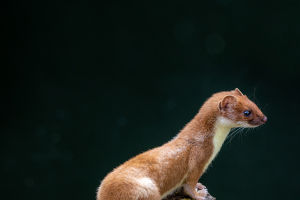The pine marten, also known as the forest marten, is a medium-sized animal under the genus Mink in the family Mustelidae. They are distributed throughout Europe, from as far west as England.
They can be found as far north as Norway and Sweden, making the entire European continent their home.
Pine martens are similar in size to a fat domestic cat, with an average body length of 50 cm or less, a tail length of 25 cm, and an average weight of about 1.6 kg. There are significant differences in body size between males and females, with males generally being about 10-30% larger than females.
They have long, slender bodies, short, thin forelimbs, and long, thick hindlimbs. Their claws are well-developed and sharp, often semi-constricted in the palm. This allows them to climb trees and move with ease between branches, much like squirrels. Pine martens are agile and have a strong ability to climb trees, which is helpful when hunting for prey. When hunting larger prey like Wolverine, they can pop out their sharp claws and deliver a fatal blow.
Pine martens are primarily found in northern Europe, Scotland, and Wales. They were once found in northern England, but due to habitat loss and extensive hunting by humans, the species was almost extinct in England after 1900. Recently, however, suspected traces of this species were found in the New Forest National Park in southern England, which has attracted the attention of relevant nature organizations and animal protection groups.
They immediately launched research and investigation to verify the sightings.
The pine marten has a highly developed sense of hearing and sense of smell. Their ears are very flexible and can turn at will, making them highly effective in detecting danger. They are always probing the wind and grass around them, acting like radar to detect predators. Once they sense danger, they immediately flee without leaving a trace.
Their small head has a thick, round base and a long, pointed snout. If you divide their small head into four, the front quarter of the head is their long, narrow protruding snout. Open their mouth, and you will find a well-developed set of canine teeth with a crown above the incisors and molars, which they use to shred prey and peel off fruit. The crown of the teeth is higher than the incisors and molars and is an excellent tool for shredding prey and peeling off the fruit.
The pine marten's short, rounded ears are impartially positioned three-quarters of the way up. Their ears are so flexible that they can not only turn at will but also have a keen sense of hearing. They are like two high-precision spy radars that do not miss the slightest noise and can detect the location of predators. This ability helps them avoid potential danger.
Pine martens have hair all over their body. Their head, face, and limbs have short, coarse, dark brown hair, while the back and tail have long, dense, light brown hair that is soft and hard. The inner ear is densely covered with long hair, which plays a better role in collecting sound and enhances keen hearing.
The hair on their back and tail is considered a prized possession among hunters, while fashionable ladies consider it an excellent material for making furs.
The pine marten has the ability to adapt to its environment by changing its coat with the seasons. When the cold autumn and winter come, their coats will gradually become longer and thicker, and the color of their coats will change from dark brown to light brown. They are like wearing a thick brown coat to withstand the cold and long winter.


